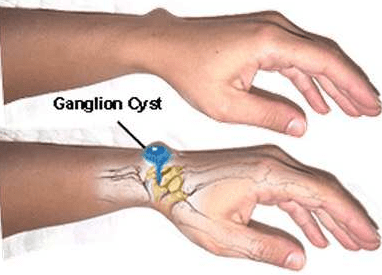ganglion-removal

Ganglion cysts are noncancerous lumps that most commonly develop along the tendons or joints of your wrists or hands. They also may occur in the ankles and feet. Ganglion cysts are typically round or oval and are filled with a jellylike fluid. Small ganglion cysts can be pea-sized, while larger ones can be around an inch (2.5 centimeters) in diameter. Ganglion cysts can be painful if they press on a nearby nerve. Their location can sometimes interfere with joint movement.
Symptoms
The lumps associated with ganglion cysts can be characterized by:
✔ Location: Ganglion cysts most commonly develop along the tendons or joints of your wrists or hands. The next most common locations are the ankles and feet. These cysts can occur near other joints as well.
✔ Shape and size: Ganglion cysts are round or oval and usually measure less than an inch (2.5 centimeters) in diameter. Some are so small that they can’t be felt. The size of a cyst can fluctuate, often getting larger when you use that joint for repetitive motions.
✔ Pain: Ganglion cysts usually are painless. But if a cyst presses on a nerve — even if the cyst is too small to form a noticeable lump — it can cause pain, tingling, numbness or muscle weakness.
Causes:
No one knows exactly what causes a ganglion cyst to develop. It grows out of a joint or the lining of a tendon, looking like a tiny water balloon on a stalk, and seems to occur when the tissue that surrounds a joint or a tendon bulges out of place. Inside the cyst is a thick lubricating fluid similar to that found in joints or around tendons.
Treatment
If your ganglion cyst is causing you problems, your plastic surgeon may suggest trying to drain the cyst with a needle. Removing the cyst surgically also is an option.
